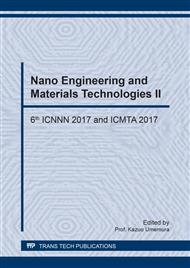[1]
A. Shah, S. Izman, M. R. Abdul-Kadir, M. A. Hassan, M. Anwar and A. Ma'aram. Influence of Bias Voltage on Corrosion Resistance of TiN Coated on Biomedical TiZrNb Alloy. Advanced Materials Research. 845 (2014) 436-440.
DOI: 10.4028/www.scientific.net/amr.845.436
Google Scholar
[2]
L. Casabán Julián and A. Igual Muñoz. Influence of Microstructure of HC CoCrMo Biomedical Alloys on the Corrosion and Wear Behaviour in Simulated Body Fluids. Tribology International. 44 (2011) 318-329.
DOI: 10.1016/j.triboint.2010.10.033
Google Scholar
[3]
S. Mischler and A. I. Muñoz. Wear of CoCrMo Alloys Used in Metal-on-Metal Hip Joints: A Tribocorrosion Appraisal. Wear. 297 (2013) 1081-1094.
DOI: 10.1016/j.wear.2012.11.061
Google Scholar
[4]
H. Mas Ayu, S. Izman, R. Daud, G. Krishnamurithy, A. Shah , S. H. Tomadi and M. S. Salwani. Surface Modification on CoCrMo Alloy to Improve the Adhesion Strength of Hydroxyapatite Coating. Procedia Engineering. 184 (2017) 399 – 408.
DOI: 10.1016/j.proeng.2017.04.110
Google Scholar
[5]
R. I. M. Asri, W. S. W. Harun, M. A. Hassan, S. A. C. Ghani and Z. Buyong. A Review of Hydroxyapatite-Based Coating Techniques: Sol–Gel and Electrochemical Depositions on Biocompatible Metals. Journal of the Mechanical Behavior of Biomedical Materials. 57 (2016).
DOI: 10.1016/j.jmbbm.2015.11.031
Google Scholar
[6]
S. Izman, A. Shah, M. R. Abdul-Kadir, E. M. Nazim, M. Anwar, M. A. Hassan and H. Safari. Effect of Thermal Temperature on Rutile Structure Formation of Biomedical TiZrNb Alloy. Advanced Materials Research. 393-395 (2012) 704-708.
DOI: 10.4028/www.scientific.net/amr.393-395.704
Google Scholar
[7]
M. Hasegawa, K. Yoshida, H. Wakabayashi and A. Sudo. Cobalt and Chromium Ion Release after Large-Diameter Metal-on-Metal Total Hip Arthroplasty. The Journal of Arthroplasty. 27 (2012) 990-996.
DOI: 10.1016/j.arth.2011.12.016
Google Scholar
[8]
J. Christopher, L. J. Henrik, R. D. Benn, L. S. Sune and B. L. Jes. Chromium and Cobalt Ion Concentrations in Blood and Serum Following Various Types of Metal-on-Metal Hip Arthroplasties. Acta Orthopaedica. 84 (2013) 229-236.
DOI: 10.3109/17453674.2013.792034
Google Scholar
[9]
A. Celik, O. Bayrak, A. Alsaran, I. Kaynaz and A. F. Yetim. Effects of Plasma Nitriding on Mechanical and Tribological Properties. Surface and Coatings Technology. 202 (2008) 2433-2438.
DOI: 10.1016/j.surfcoat.2007.08.030
Google Scholar
[10]
A. Igual Muñoz and S. Mischler. Effect of the Environment on Wear Ranking and Corrosion of Biomedical Cocrmo Alloys. J. Mater. Sci.: Mater. Med. 22 (2011) 437-450.
DOI: 10.1007/s10856-010-4224-0
Google Scholar
[11]
R. Varano, J. D. Bobyn, J. B. Medley and S. Yue. The Effect of Microstructure on the Wear of Cobalt-Based Alloys Used in Metal-on-Metal Hip Implants. Journal of Engineering in Medicine. 220 (2) (2006) 145-159.
DOI: 10.1243/09544119jeim110
Google Scholar
[12]
D. Stanley, B. Vamsi Krishna, M. D. Neal, B. Susmita and B. Amit. In Vitro Wear Rate and Co Ion Release of Compositionally and Structurally Graded CoCrMo-Ti6Al4V Structures. Materials Science Engineering: C. 31 (2011) 809-814.
DOI: 10.1016/j.msec.2010.07.009
Google Scholar
[13]
Y. Yan, A. Neville and D. Dowson. Tribo-Corrosion Properties of Cobalt-Based Medical Implant Alloys in Simulated Biological Environments. Wear. 263 (2007) 1105-1111.
DOI: 10.1016/j.wear.2007.01.114
Google Scholar
[14]
A. Igual Munoz and S. Mishler. Effect of the Environment on Wear Ranking and Corrosion of Biomedical CoCrMo Alloys. Journal of Materials Science: Materials in Medicine. 22 (2011) 437-450.
DOI: 10.1007/s10856-010-4224-0
Google Scholar
[15]
H. Mas-Ayu, S. Izman, Mohammed Rafiq Abdul-Kadir, Rosdi Daud, A. Shah, Mohd Faiz Mohd Yusoff, M. W. Shamsiah, T. M. Yong and T. Kamarul. Influence of Carbon Concentrations in Reducing Co and Cr Ions Release in Cobalt Based Implant: A Preliminary Report. Advanced Materials Research. Volume 845 (2014).
DOI: 10.4028/www.scientific.net/amr.845.462
Google Scholar
[16]
S. Izman, M. A. Hassan, A. K. Mohammed Rafiq, M. R. Abdullah, M. Anwar, A. Shah and R. Daud. Effect of Pretreatment Process on Thermal Oxidation of Biomedical Grade Cobalt Based Alloy. Advanced Materials Research. 399-401 (2012) 1564-1567.
DOI: 10.4028/www.scientific.net/amr.399-401.1564
Google Scholar
[17]
H. Buscail, F. Riffard, C. Issartel and S. Perrier. Oxidation Mechanism of Cobalt Based Alloy at High Temperatures (800-1100°C). Corrosion, Engineering and Science Technology. 47 (2012) 404-410.
DOI: 10.1179/1743278212y.0000000007
Google Scholar
[18]
P. J. Blau, T. M. Brummett and B. A. Pint. Effects of Prior Surface Damage on High-Temperature Oxidation of Fe-, Ni-, and Co-Based Alloys. Wear. 267 (2009) 380-386.
DOI: 10.1016/j.wear.2008.12.082
Google Scholar


